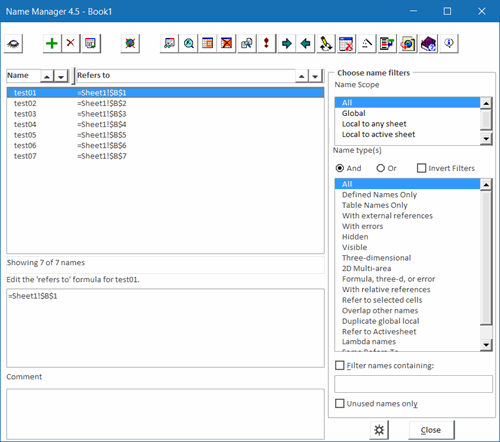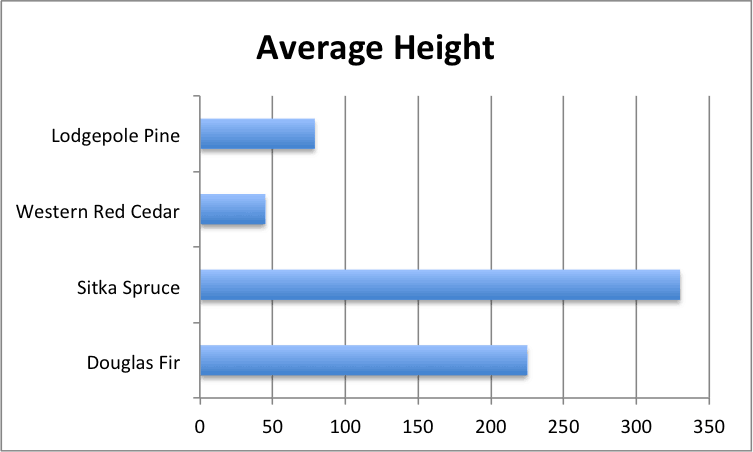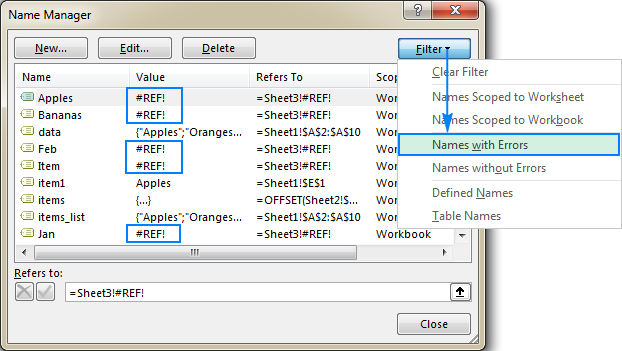

- See name manager functions making a chart excel for mac install#
- See name manager functions making a chart excel for mac download#
- See name manager functions making a chart excel for mac windows#
Note that BI Publisher defined names are within the scope of the template sheet. The defined names used in your Excel template must use the syntax described in this chapter, as well as follow the Microsoft guidelines described in the Microsoft Excel help document. Tip: To learn more about defined names and their usage in Microsoft Excel 2007, see the Microsoft help topic: "Define and use names in formulas." A defined name in Excel is a name that represents a cell, range of cells, formula, or constant value.

The Excel defined names feature is used to identify data fields and repeating elements. Note: See Preprocessing the Data Using an XSL Transformation (XSLT) File and Grouping Functions for more information about these options. However, for the best performance and least complexity it is recommended that the data model be designed with the report layout in mind. If your data is not structured to match the desired layout in Excel it is possible to regroup the data using XSLT preprocessing or the grouping functions. Each group of repeating elements in your template must correspond to a parent-child relationship in the XML file. Your template content and layout must correspond to the content and hierarchy of the XML data file used as input to your report. The cell names are also used to establish a mapping within the template between the named cell and calculations and formatting instructions that are defined on the XDO_METADATA sheet. Cells are named using BI Publisher syntax to establish the mapping back to the XML data. Identifying Data Field Placeholders and GroupsĮxcel templates use named cells and groups of cells to enable BI Publisher to insert data elements. In addition to direct mapping of data elements, Excel templates also utilize a special sheet (the XDO_METADATA sheet) to specify and map more complex formatting instructions. Excel templates make use of features of Excel in conjunction with special BI Publisher syntax to achieve this mapping.

Similar to RTF template design, Excel template design follows the paradigm of mapping fields from your XML data to positions in the Excel worksheet. This will launch the folder that contains the Excel sample templates.
See name manager functions making a chart excel for mac windows#
To access the samples from a Windows desktop:Ĭlick Start, then Programs, then Oracle BI Publisher Desktop, then Samples, then Excel. The Template Builder includes sample Excel templates.
See name manager functions making a chart excel for mac download#
Under the Get Started region, click Download BI Publisher Tools. The tools can be downloaded from the Home page of Oracle Business Intelligence Publisher or Oracle Business Intelligence Enterprise Edition, as follows:
See name manager functions making a chart excel for mac install#
The Template Builder for Excel is installed automatically when you install the Template Builder for Word. This facilitates design by enabling you to test and edit your template without having to upload it to the BI Publisher catalog first. Desktop ToolsīI Publisher provides a downloadable add-in to Excel that enables you to preview your template with sample data. To use some of the advanced features, the report designer will need knowledge of XSL and XSLT.Įxcel templates generate Excel binary (.xls) output only. The template file must be saved as Excel 97-2003 Workbook binary format (*.xls). Some features require the use of XSL and XSL Transformation (XSLT) specificationsįollowing are prerequisites for designing Excel templates: There is no tool to facilitate the markup of the template with BI Publisher tags all tags must be manually coded. If the template sheet includes images, when the data is split into multiple sheets, the images will show only on the first sheet. The following are limitations of Excel templates:įor reports that split the data into multiple sheets, images are not supported. Use native XSL functions in your data to manipulate it prior to rendering Split hierarchical data across multiple sheets and dynamically name the sheetsĬreate sheets of data that have master-detail relationships Features of Excel Templatesĭefine the structure for your data in Excel output Excel templates provide a set of special features for mapping data to worksheets and for performing additional processing to control how your data is output to Excel workbooks. Using the Template Viewer to Debug a TemplateĪn Excel template is a report layout that you design in Microsoft Excel for retrieving and formatting your enterprise reporting data in Excel.Preprocessing the Data Using an XSL Transformation (XSLT) File.This chapter covers the following topics: Oracle Fusion Middleware Report Designer's Guide for Oracle Business Intelligence Publisher Creating Excel Templates Browser version script Skip Headers


 0 kommentar(er)
0 kommentar(er)
